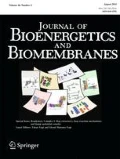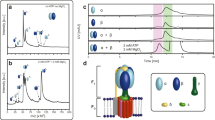Abstract
The ATPase activity of the F1-ATPase from the thermophilic bacterium PS3 is stimulated at concentrations of rhodamine 6G up to about 10 µM where 70% stimulation is observed at 36°C. Half maximal stimulation is observed at about 3 µM dye. At rhodamine 6G concentrations greater than 10 µM, ATPase activity declines with 50% inhibition observed at about 75 µM dye. The ATPase activities of the α3β3γ and α3β3γδ complexes assembled from isolated subunits of TF1 expressed inE. coli deleted of theunc operon respond to increasing concentrations of rhodamine 6G nearly identically to the response of TF1. In contrast, the ATPase activities of the α3β3 and α3β3δ complexes are only inhibited by rhodamine 6G with 50% inhibition observed, respectively, at 35 and 75 µM dye at 36°C. The ATPase activity of TF1 is stimulated up to 4-fold by the neutral detergent, LDAO. In the presence of stimulating concentrations of LDAO, the ATPase activity of TF1 is no longer stimulated by rhodamine 6G, but rather, it is inhibited with 50% inhibition observed at about 30 µM dye at 30°C. One interpretation of these results is that binding of rhodamine 6G to a high-affinity site on TF1 stimulates ATPase activity and unmasks a low-affinity, inhibitory site for the dye which is also exposed by LDAO.
Similar content being viewed by others
References
Aggeler, R., and Capaldi, R. A. (1992).J. Biol. Chem. 267, 21355–21359.
Aggeler, R., Chicas-Cruz, K., Cai, S-X., Keana, J. F. W., and Capaldi, R. A. (1992).Biochemistry 31, 2956–2961.
Bullough, D. A., Kwan, M., Laikind, P. K., Yoshida, M., and Allison, W. S. (1985).Arch. Biochem. Biophys. 236, 567–575.
Bullough, D. A., Ceccarelli, E. A., Roise, D., and Allison, W. S. (1989a).Biochim. Biophys. Acta 975, 377–383.
Bullough, D. A., Ceccarelli, E. A., Verburg, J. G., and Allison, W. S. (1989b).J. Biol. Chem. 264, 9155–9163.9.
Chazotte, B., Vanderkooi, G., and Chignell, D. (1982).Biochim. Biophys. Acta 680, 310–316.
Dallmann, G. H., Flynn, T. G., and Dunn, S. D. (1992).J. Biol. Chem. 267, 18953–18960.
Dunn, S. D., Tozer, R. G., and Zadorozny, V. D. (1990).Biochemistry 29, 4335–4340.
Emaus, R. K., Gruenwald, R., and Lemasters, J. J. (1986).Biochim. Biophys. Acta 850, 436–448.
Kagawa, Y., Ohta, S., and Otawara-Hamamoto, Y. (1989).FEBS Lett. 249, 67–69.
Kagawa, Y., Ohta, S., Harada, M., Kihara, H., Ito, Y., and Sato, M. (1992).J. Bioenerg. Biomembr. 24, 441–445.
Klionsky, D. J., Brusilow, W. S. A., and Simoni, R. D. (1984).J. Bacteriol. 160, 1055–1060.
Laikind, P. K., Goldenberg, T. M., and Allison, W. S. (1982).Biochem. Biophys. Res. Commun. 109, 423–427.
Lötscher, H-R., deJong, C., and Capladi, R. A. (1984).Biochemistry 23, 4140–4143.
Miwa, K., and Yoshida, M. (1989).Proc. Natl. Acad. Sci. USA 86, 6484–6487.
Ohta, S., Yohda, M., Ishuzuka, M., Hirata, H., Hamamoto, T., Otawara-Hamamoto, Y., Matsuda, K., and Kagawa, Y. (1988).Biochim. Biophys. Acta 933, 141–155.
Palatini, P. (1982).Mol. Pharmacol. 21, 415–421.
Penefsky, H. S., and Cross, R. L. (1991).Adv. Enzymol. 64, 173–214.
Senior, A. E. (1988).Physiol. Rev. 68, 177–231.
Wieker, H-J., Kuschmitz, D., and Hess, B. (1987).Biochim. Biophys. Acta 892, 108–117.
Yokoyama, K., Hisabori, T., and Yoshida, M. (1989).J. Biol. Chem. 264, 21837–21841.
Yoshida, M., and Allison, W. S. (1986).J. Biol. Chem. 261, 5714–5721.
Yoshida, M., Sone, N., Hirata, H., and Kagawa, Y. (1975).J. Biol. Chem. 250, 7910–7916.
Yoshida, M., Sone, N., Hirata, H., and Kagawa, Y. (1977).J. Biol. Chem. 252, 3480–3485.
Zhuo, S., and Allison, W. S. (1988).Biochem. Biophys. Res. Commun. 152, 968–972.
Zhuo, S., Paik, S. R., Register, J. A., and Allison, W. S. (1993).Biochemistry 32, 2219–2227.
Author information
Authors and Affiliations
Rights and permissions
About this article
Cite this article
Paik, S.R., Yokoyama, K., Yoshida, M. et al. The TF1-ATPase and ATPase activities of assembled α3β3γ, α3β3γδ, and α3β3γε complexes are stimulated by low and inhibited by high concentrations of rhodamine 6G whereas the dye only inhibits the α3β3, and α3β3δ complexes. J Bioenerg Biomembr 25, 679–684 (1993). https://doi.org/10.1007/BF00770254
Received:
Accepted:
Issue Date:
DOI: https://doi.org/10.1007/BF00770254




